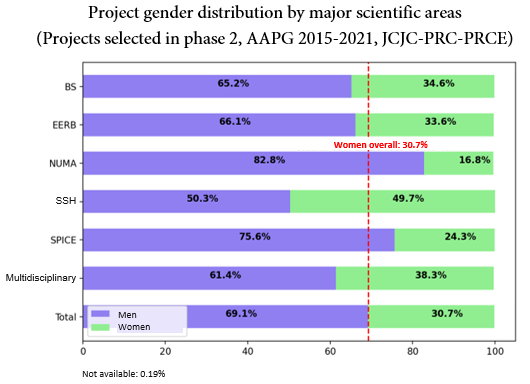Scientific women and men in the Generic Call for Proposals: ANR publishes analyses over the 2015-2021 period

Download the “Scientific women and men in the AAPG 2015 – 2021” Report
Identifying possible gender biases in the evaluation and monitoring changes in practices
To identify lines of action to fight against gender inequalities in Higher education and research (ESR), the ANR has been conducting statistical analyses since 2017 using data from its calls for proposals, in particular the AAPG, the agency’s main call. These analyses allow the identification of possible gender biases in the evaluation and show the changes in practices for women and men in terms of responding to an ANR call for proposals. The Agency is also implementing other actions, such as the systematic search for parity in Scientific Evaluation Panels (CES) or the training of chairpersons, to minimise possible gender biases in evaluation processes.
An increase in the number of projects submitted by women between 2015 and 2021

The analyses conducted on projects of the AAPG 2015-2021 show that the proportion of projects led by women matches the proportion of women in ESR. The number of projects submitted by men has been decreasing between 2015 and 2021 (322 fewer projects), whereas over the same period, the number of projects submitted by women has increased (+ 337 projects). Over the same period, the proportion of female coordinators submitting projects has increased by 5 points.

The number of JCJC projects, an instrument dedicated to young researchers, led by women experienced a slight decrease in 2021. However, JCJC remains the preferential instrument for women to invest in, with an increase of 6 points between 2015 and 2021, while the proportion of projects led by men, within the same instrument, falls by 5 points over the same period. In addition, the analyses show that the number of PRC collaborative research projects between public entities, and PRCE with an opening to the business world, led by women has increased in 2021. Like women, more men submitted a PRC and PRCE project in 2021 than in 2020.
An increasing number of selected women-led projects

The distribution of selected projects follows the same pattern as those observed during the project submission, namely an average proportion of women amounting to 30.7% of the workforce against 69.1% of men over the entire 2015-2021 period.
The proportion of projects led by women within the projects selected grew from edition to edition, going from 28.2% in 2015, to 33.3% over 1,654 projects selected in 2021. The proportion of women whose projects have been selected increased by 7 points for JCJC projects, by 2 points for PRC projects, and by 8 points for PRCE projects between 2015 and 2021.
Disparities between scientific fields

Gender distribution varies among the projects selected, depending on scientific fields and communities. The proportions are very similar to those observed for the submission of research proposals, with a balanced proportion of women and men in Social sciences and humanities (SSH), and a lower proportion of women in all other fields. After SSH, the proportion of women whose projects were selected is the highest in the “multidisciplinary” field, compared to other fields (38.3% of women-led projects).
Significantly different profiles between male and female coordinators of funded projects

Funded men are younger than women in JCJC projects: 40% of them are less than 34 years old, against only 34% for women.
For PRC and PRCE, we can also see that women appear later than men, and that they are still present in the 45-49 age group, while at this age, the presence of men begins to diminish.
In addition, female coordinators for ANR projects are more present as research fellows (35.1% of RF vs 28.7% of project leaders) or lecturers (34.4% of LECT vs 23% of professors), whereas male project coordinators are equally present, regardless of their career level.
Read the full analyses in the dedicated report (30 pages).
Download the “Scientific women and men in the AAPG 2015 – 2021” Report
Find out more:
ANR’s commitments for gender equality and gender mainstreaming
ANR rolls out an action plan for gender equality and gender mainstreaming
Analyses on “Scientific women and men in the Generic call for proposals from 2014 to 2016”


